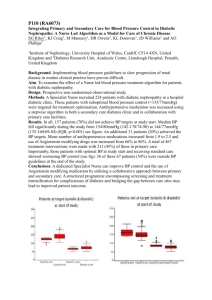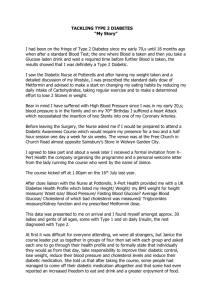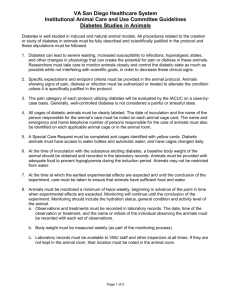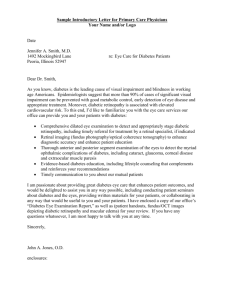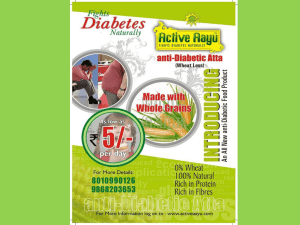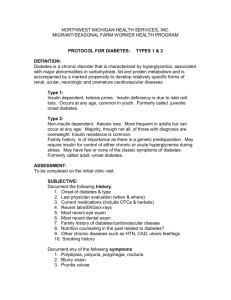UNIVERSITY OF KRAGUJEVAC
advertisement
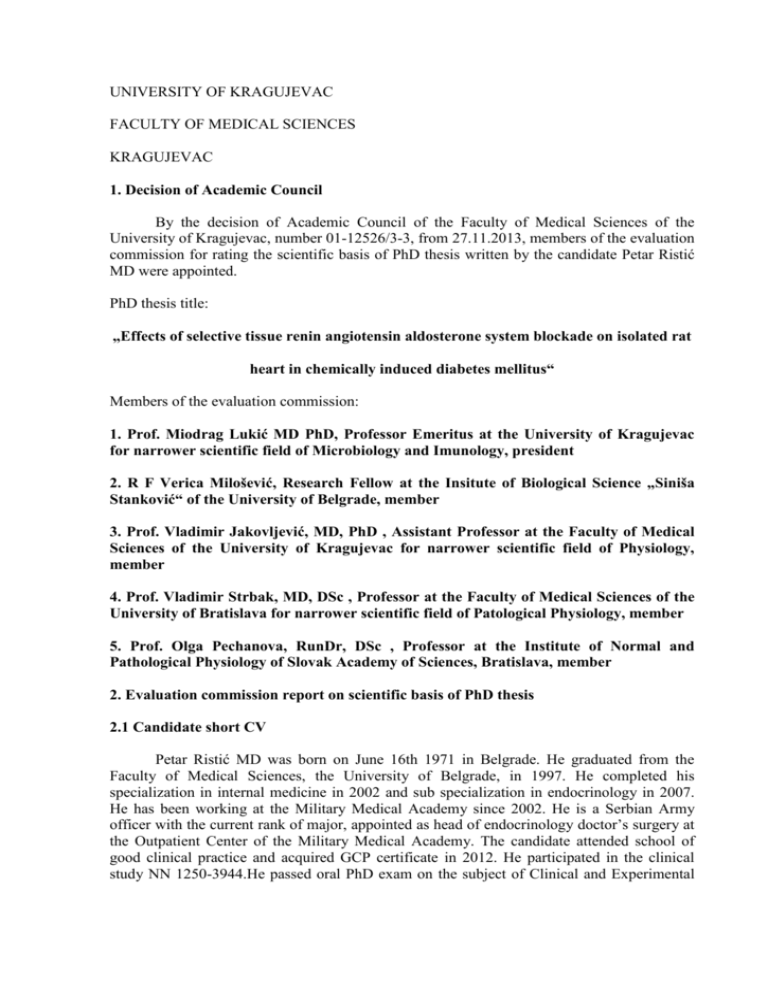
UNIVERSITY OF KRAGUJEVAC FACULTY OF MEDICAL SCIENCES KRAGUJEVAC 1. Decision of Academic Council By the decision of Academic Council of the Faculty of Medical Sciences of the University of Kragujevac, number 01-12526/3-3, from 27.11.2013, members of the evaluation commission for rating the scientific basis of PhD thesis written by the candidate Petar Ristić MD were appointed. PhD thesis title: „Effects of selective tissue renin angiotensin aldosterone system blockade on isolated rat heart in chemically induced diabetes mellitus“ Members of the evaluation commission: 1. Prof. Miodrag Lukić MD PhD, Professor Emeritus at the University of Kragujevac for narrower scientific field of Microbiology and Imunology, president 2. R F Verica Milošević, Research Fellow at the Insitute of Biological Science „Siniša Stanković“ of the University of Belgrade, member 3. Prof. Vladimir Jakovljević, MD, PhD , Assistant Professor at the Faculty of Medical Sciences of the University of Kragujevac for narrower scientific field of Physiology, member 4. Prof. Vladimir Strbak, MD, DSc , Professor at the Faculty of Medical Sciences of the University of Bratislava for narrower scientific field of Patological Physiology, member 5. Prof. Olga Pechanova, RunDr, DSc , Professor at the Institute of Normal and Pathological Physiology of Slovak Academy of Sciences, Bratislava, member 2. Evaluation commission report on scientific basis of PhD thesis 2.1 Candidate short CV Petar Ristić MD was born on June 16th 1971 in Belgrade. He graduated from the Faculty of Medical Sciences, the University of Belgrade, in 1997. He completed his specialization in internal medicine in 2002 and sub specialization in endocrinology in 2007. He has been working at the Military Medical Academy since 2002. He is a Serbian Army officer with the current rank of major, appointed as head of endocrinology doctor’s surgery at the Outpatient Center of the Military Medical Academy. The candidate attended school of good clinical practice and acquired GCP certificate in 2012. He participated in the clinical study NN 1250-3944.He passed oral PhD exam on the subject of Clinical and Experimental Internal Medicine in March 2011 at the Faculty of Medical Sciences, the University of Kragujevac . The candidate is able to use computers and speaks English fluently. 2.2 Title, subject and hypothesis of doctoral dissertation Title: Effects of selective tissue renin angiotensin aldosterone system blockade on isolated rat heart in chemically induced diabetes mellitus Subject: Determining a change in the function of myocardium and coronary flow caused by the animal model of diabetic cardiomyopathy Hypothesis: Diabetic cardiomyopathy is mostly presented with diastolic dysfunction, to a lesser extent with systolic dysfunction, while coronary auto regulation is slightly altered in terms of increased rigidity of blood vessels. 2.3. Candidate suitability The canditate has one article published in the scientific journal from CC/SCI list as the first autor. Due to this fact the candidate meets the requirement for applying for the PhD thesis. Ristic P, Bokonjic D, Zivkovic V, Jakovljevic V, Zdravkovic M, Pejovic J, Ristic D, Mladenovic J. Subcutaneous adipose tissue measurements and better metabolic prediction. Central European Journal of Medicine 2013; 8(2): 237-43 М23=3 points. 2.4 Overview of the field of research Diabetes mellitus is the chronic condition with constantly rising incidence and prevalence. Chronic metabolic disorders affect every organ system in the body and lead to their disfunction. Therefore chronic diabetic complications are the biggest challenge and the highest cost in diabetic patients management, which was the conclusion of the extensive CODE2 study. Cardiovascular disease is 2-4 times more common among diabetic patients and it is the leading cause of their mortality. When we analyze myocardial infarctation, the mortality of diabetics is 4 times higher for men and 7 times for women than the mortality of nondiabetics. This leads to the conclusion that there is a specific cardiovascular damage caused by diabetes. Diabetic cardiomyopathy (DCMP) is the term introduced by Rubler in 1972, when he described patohistological alterations in diabetic myocardium in absence of ishemia, arterial hypertension or alcoholism. It is characterised by predominantly diastolic disfunction followed by later sistolic disfunction. Scientific focus regarding pathogenesis of DCMP is on RAAS which was realised to be the main modulator of chronic hyperglicemia influences on tissues. Diabetes mellitus is characterised by the enhanced RAAS activity in tissues . More than 90% of RAAS is tissue RAAS, however this is not the only distinction since there are intracellular and extracellular tissue RAAS as well . These systems are in constant interaction, however there are some differences in the way they synthesize key metabolits and therefore in the way they react on modern RAAS blocking options. Tissue RAAS is synthesized both in cardiomyocites and heart fibroblasts. Extracellular Angiotensine II (ATII) regulates arterial tension, fluid and electrolite homeostasis while intracellular tissue RAAS enables long lastig RAAS stimulation by increasing genetic expresion of angiotensinogen, renin and AT1 receptors for ATII both in cardiomyocytes and heart fibroblasts. These two elements of tissue RAAS act synergistically. Diabetic patients have 3.4 times higher intracellularATII than nondiabetics and even double more if they have arterial hypertension combined. Intracellular tissue ATII has dual origin, some is synthesized in cells from intracellularly made angiotensinogen, renin and chimazas and on the other hand it might be internalized after secretion by the cell through AT1 receptors. Intracellular ATII sythesis is mostly managed by chymasas and not by ACE. Therefore ACEI can not significantly reduce intracellular ATII. In hyperglicemic state cardyomyocites produce ATII predominantly intracellularly involving renin and chymasas whilst in the case of fibroblasts renin and ACE are involved both intracellularly and extracellularly. So ACEI act predominantly on tissue RAAS made in heart fibroblasts. ARBs are also not able to block intracellular tissue RAAS entirely. Zofenopril is lipophile ACEI with sulfhydryl group and significant effects on tissues . Recently it has become obvious that previous RAAS blocade modalities (ACEI, ARBs) are not efficient enough particulary in blocking tissue RAAS. Such medication should be involved in chronic diabetic complications prevention. Absolute blockage of RAAS should not be a goal. In December 2012 a large international study group reported results indicating that the addition of aliskiren to classic RAAS blockers like ACEI or ARB does not lead to improvement, on the contrary such method is not recomended . Aldosterone is produced in the adrenal gland but there is tissue production as well. We can differentiate genomic and nongenomic effects of aldosterone.Nongenomic effects start more quickly. Aldosterone contributes to development of cardial fibrosis mostly by potentiating ATII effects on AT1 receptor. Many of these negative effects are mediated through mineralocorticoid receptors (MR). After long lasting RAAS blockade with ACEI and ARBs aldosteron concentration starts to rise despite larger doses or combined administration .This phenomenon is called aldosterone escape.In isolated heart experiment both aldosterone and direct blocker of its receptor produced similar nongenomic effect- positive inotropic , and this was even enhanced with combined perfusion which makes investigations of spirinolactone effects on diabetic cardiomyopathy interesting and intriguing. ARBs act mostly by controlling oxidative stress effects on myocard tissue. On the other hand, effects of ACEI are usually driven from modulation of L-arginin NO system. Earlier it was considered that ACEI effects involve bradikinin system but later findings suggest that it is not the case. When ACE is inhibited angiotensin I is in greater extent converted by ACE2 whose product is angiotensin (1-7), molecule with vasodilatative properties. Oxidative stress and L-arginin NO system parameters are very important for proper understanding of RAAS blockade in diabetic cardiomyopathy. 2.5. The importance and purpose of the research Importance of the study Cardiovascular disease is the leading cause of mortality among diabetic patients and it strikes this group significantly more often and more severely than general population. Diabetic cardiomyopathy (DCMP) presents initially with diastolic dysfunction which is later accompanied by systolic dysfunction as well. These events precede ischemic heart disease. Major cause of tissue remodelling in diabetes is hyperglycemia and it is the most significant modulator of excessive activity of rennin angiotensin aldosterone system (RAAS) particularly tissue RAAS. Among other known effects RAAS in this matter predominantly acts via modulation of oxidative stress. Complexity of this matter comes from the ability of tissues to produce almost all elements of RAAS and from the presentation of their receptors both on cell surface and inside the cell. At this moment RAAS blockade is managed with ACE inhibitors, blockers of AT1 receptor for angiotensin II (ARBs), direct rennin inhibitors, and blockers of the aldosterone receptor. Every method has its own contribution, but there are important differences as well. Aim and hypothesis Basic hypothesis is that diabetic cardiomyopathy is largely presented with diastolic dysfunction, to a lesser extent systolic dysfunction while coronary auto regulation is slightly altered in terms of increased rigidity of blood vessels. General aim of this study is to induce insulinopenic diabetes with chemical method using 60mg/kg of streptozotocin ip, than to determine cardiodynamic parameters and parameters of coronary blood flow autoregulation in Langendorf model of isolated heart in control group of healthy rats, those with diabetic cardiomyopathy and in all predetermined groups according to the protocol of investigation. The role of oxidative stres and L-arginin NO system will be monitored in all groups as well. 2.6. Relation of this study to previous research Cardiovascular disease is the leading cause of mortality among diabetic patients and it strikes this group significantly more often and more severely than general population. Diabetic cardiomyopathy (DCMP) presents initially with diastolic dysfunction which is later accompanied by systolic dysfunction as well. These events precede ischemic heart disease. Major cause of tissue remodelling in diabetes is hyperglycemia and it is the most significant modulator of excessive activity of rennin angiotensin aldosterone system (RAAS) particularly tissue RAAS. Among other known effects RAAS in this matter predominantly acts via modulation of oxidative stress. Complexity of this matter comes from the ability of tissues to produce almost all elements of RAAS and from the presentation of their receptors both on cell surface and inside the cell. At this moment RAAS blockade is managed with ACE inhibitors, blockers of AT1 receptor for angiotensin II (ARBs), direct rennin inhibitors, and blockers of the aldosterone receptor. Every method has its own contribution, but there are important differences as well. All RAAS blocking agents act mostly by controling oxidative stress effects on myocard tissue and by modulation of L-arginin NO system. Earlier it was considered that ACEI effects involve bradikinin system but later findings suggest that it is not the case. When ACE is inhibited angiotensin I is in greater extent converted by ACE2 whose product is angiotensin (1-7), molecule with vasodilatative properties. Oxidative stress and L-arginin NO system parameters are very important for the proper understanding of RAAS blockade in diabetic cardiomyopathy. 2.7 Method of research Type of study: Experimental study Researched population: We are planning to use 140 male Wistar albino rats aged 8weeks with average body mass of 180-200 gr. Animals will be held in the stable enviroment in metal cages with the temperature of 23 C and with 12 hour light and dark cycle. Usual laboratory chow and water will be presented ad librum. Before induction of diabetes two weeks of adaptation will be provided. Induction of diabetes will start after 12 hours of fast. After dissolving streptozocin in 1ml of 0.05M cold citrate bufer of PH 4.5, it will be given to the rats i.p. in dorsal posion in lower abdominal cavity using steril 25G needle and the dosage will be 60mg/kg. This method of administration prevents eventual effects of streptozotocin solution to acido-basic balance, because the solution is very acidic.This model of inducing diabetes provides hypoinsulinemic hyperglicemia without ketosis or electrolite disturbance. Previously the skin will be swabbed with iodine solution at the place of administration. For diagnosis of diabetes we will accept animals with blood glucose level > 11.1mmol/l any time after 24hours after the streptozocin injection. Usually it takes 48-76 hours for diabetes to develop. Blood samples for glucose measurments will be taken from tail vein. Animals that developed diabetes will be held in the same conditions for the next 4 weeks.Duration of hyperglicemia prior to euthanasia was determined after analyzing the results presented in previous studies on diabetic rats. Based on a detailed overview of several models of induction of diabetes in rats and the development of initial diabetic cardiomyopathy which is the topic of this study, the conclusion is that the first changes in diastolic function of the left ventricule measured on isolated rat heart develop after 7 days while changes of pressure in the left ventricule wall during systola ( LV dP/dt max) can be registered after 21 days. In case of cardiomyopathy which is determined by the ultrasound this time period is 12 weeks. After eutanasia isolated hearts will be prepared according to modified retrogradly perfused heart Langendorff protocol. The experiment is approved by Ethics commitee for experimental animal well being of the Medical Faculty of the University of Kragujevac. Materials and methods Induction of diabetes will start after 12 hours of fast. After dissolving streptozocin in 1ml of 0.05M cold citrate bufer PH 4.5, 60mg/kg of it will be given i.p. in dorsal posion in lower abdominal cavity using steril 25G needle. This method of administration prevents eventual effects of streptozotocin solution to acido-basic balance, because the solution is very acidic.This model of inducin diabetes provides hypoinsulinemic hyperglicemia without ketosis or electrolite disturbance. Previously skin will be swabbed with iodine solution at the place of administration. For diagnosis of diabetes we will accept animals with blood glucose level > 11.1mmol/l any time after 24 hours after the streptozocin injection. Usually it takes 48-76 hours for diabetes to develop. Blood samples for glucose measurments will be taken from tail vein. Animals that developed diabetes will be held in the same conditions for the next 4 weeks.Duration of hyperglicemia prior to euthanasia was determent after analyzing the results presented in previous studies on diabetic rats. Based on a detailed overview of several models of induction of diabetes in rats and the development of initial diabetic cardiomyopathy which is the topic of this study, first changes in diastolic function of the left ventricule mesured on isolated rat heart develop after 7 days while changes of pressure in the left ventricule wall during systola ( LV dP/dt max) can be registered after 21 days. In case of cardiomyopathy which is determined by the ultrasound this time period is 12 weeks. After eutanasia isolated hearts will be prepared according to the modified retrogradly perfused heart Langendorff protocol. According to the protocol there will be 11 groups of 12 animals: 1. Healthy animals with pure Krebs-Hensenlit solution 2. DCMP with pure Krebs-Hensenlit solution 3. Healthy animals + Aliskiren (4.5 µM) 4. DCMP + Aliskiren (4.5µM) 5. DCMP + Zofenopril (1.5 µM) 6. DCMP + Valsartan (3 µM) 7. DCMP + Spirinolacton( 3 µM) 8. DCMP + Zofenopril (1.5 µM)+ Valsartan (3 µM) 9. DCMP + Valsartan (3 µM)+ Spirinolacton( 3 µM) 10. DCMP + Aliskiren (4.5µM)+ Spirinolacton( 3 µM) 11. DCMP+ Zofenopril (1.5 µM)+ Spirinolacton( 3 µM) Having in mind that for establishing the diagnosis of diabetic cardyomyopathy functional (ultrasound) or morphologic (pathohistology) conformation is needed and because of the objective technical limitations in this experiment we have chosen pathohistological confimation. Out of 12 animals in every group 6 will be taken for preparation of isolated heart by Lagendorf protocol and other 6 will be sent for patohistological verification of cardiomyopathy. As it was put in the title, the major aim of this study is to assess initial changes in myocardial function and their relation to the activity of RAAS. Therefore patohistological changes do not need to be apparent at all. We would perform histochemical staining for collagen I and III, desmin, visfatin and myotrophin. Cardiodynamic parameters and the range of coronary auto regulation will be measured on prearranged levels of perfusion pressure 40-120cm H2O.Oxidative stress and L-arginin NO system markers (TBARS, O2ˉ, H2O2, nitrite) will be determined by spectrophotometer from coronary venous effluent samples. Cardiodynamic parameters (dp/tp max, dp/tp min, SLVP, DLVP, HR, and MBP) will be measured by the sensor placed in the left ventricle using software.Blood samples taken from killed animals will be tested for HbAlc as the measurement of average glycemia in groups during the experiment and for BNP as the measurement of heart dysfunction in groups. For statistical calculation we will use two-factor analysis of variance with frequent measurements and Student T-test for connected samples. Statistical significance will be set on p<0.5 level. To calculate significance of linear relation between variables in the samples we will use Pirsons Test of linear correlation. 2.8 Expected results of the doctoral dissertation If working hypothesis is confirmed, we can expect high level of corelation of diabetic cardiomyopathy, diastolic dysfunction, systolic disfunction of left ventricule in lesser extent and insignificantly altered coronary flow in terms of increased rigidity of blood vessels . Corelation to oxidative stres and disfunction of L-arginin-NO system is expected as well. 2.9 General content of the doctoral dissertation Cardiovascular disease is the leading cause of mortality among diabetic patients and it strikes this group significantly more often and more severely than general population. Diabetic cardiomyopathy (DCMP) presents initially with diastolic dysfunction which is later accompanied by systolic dysfunction as well. These events precede ischemic heart disease. Major cause of tissue remodelling in diabetes is hyperglycemia and it is the most significant modulator of excessive activity of rennin angiotensin aldosterone system (RAAS) particularly tissue RAAS. Among other known effects RAAS in this matter predominantly acts via modulation of oxidative stress. Complexity of this matter comes from the ability of tissues to produce almost all elements of RAAS and from the presentation of their receptors both on cell surface and inside the cell. At this moment RAAS blockage is managed with ACE inhibitors, blockers of AT1 receptor for angiotensin II (ARBs), direct rennin inhibitors, and blockers of the aldosterone receptor. Every method has its own contribution, but there are important differences as well. Basic hypothesis is that diabetic cardiomyopathy is largely presented with diastolic dysfunction, to a lesser extent with systolic dysfunction while coronary auto regulation is slightly altered in terms of increased rigidity of blood vessels. 2.10 Suggestion for a mentor We suggest Prof. Vladimir Jakovljević MD PhD , Assistant Professor at the Faculty of Medical Sciences of the University of Kragujevac for narrower scientific field of Physiology be the mentor. 2.11. Scientific field of PhD thesis Medicine. Narrower scientific field: Experimental internal medicine. 2.12. Scientific field of members of scientific commission 1. Prof. Miodrag Lukić MD PhD, Professor Emeritus at the University of Kragujevac for narrower scientific field of Microbiology and Imunology, president 2. R F Verica Milošević, Research Fellow at the Insitute of Biological Science „ Siniša Stanković“ of the University of Belgrade, member 3. Prof. Vladimir Jakovljević, MD, PhD , Assistant Professor at the Faculty of Medical Sciences of the University of Kragujevac for narrower scientific field of Physiology, member 4. Prof. Vladimir Strbak, MD, DSc , Professor at the Faculty of Medical Sciences of the University of Bratislava for narrower scientific field of Patological Physiology, member 5. Prof. Olga Pechanova, RuNDd, DSc , Professor at the Institute of Normal and Pathological Physiology of Slovak Academy of Sciences, Bratislava, member Conclusion and suggestions of scientific commisson 1. After reviewing the results of the scientific work and research and publications made by Petar Ristić MD, the committee concludes that the candidate has necessary qualifications and meets all the requirements to start to work on his doctoral dissertation. 2. Presented PhD thesis is scientifically justified , the design of the study is precisely set and defined and the methodology is clear. It is an original scientific work with a purpose to develop a new aproach in investigating the role of RAAS in chemicaly induced Diabetes mellitus. 3. Scientific committee is of the opinion that presented PhD thesis by Petar Ristić MD will prove to be scientifically and practically useful for studying pathophysiological mechanisms of Diabetes mellitus. 4. This commission suggests that the Academic Council of the Faculty of Medical Sciences of the University of Kragujevac accept the PhD thesis by the candidate Petar Ristić MD titled : „Effects of selective tissue renin angiotensin aldosterone system blockade on isolated rat heart in chemically induced diabetes mellitus“ and approve its writing. Prof. Miodrag Lukić MD PhD, Professor Emeritus at the University of Kragujevac for narrower scientific field of Microbiology and Imunology, president _____________________________________________ R F Verica Milošević, Research Fellow at the Insitute of Biological Science „ Siniša Stanković“ of the University of Belgrade, member _____________________________________________ Prof. Vladimir Jakovljević, MD, PhD , Assistant Professor at the Faculty of Medical Sciences of the University of Kragujevac for narrower scientific field of Physiology, member _____________________________________________ Prof. Vladimir Strbak, MD, Dsc , Professor at the Faculty of Medical Sciences of the University of Bratislava for narrower scientific field of Patological Physiology, member ______________________________________________ Prof. Olga Pechanova, RUNDr, Dsc , Professor at the Institute of Normal and Pathological Physiology of Slovak Academy of Sciences, Bratislava, member ________ In Kragujevac, 27th December 2013
